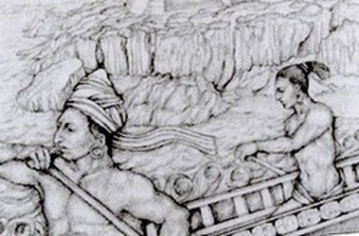|
J. William T. "Bill" Youngs, American Realities, Volume One:
Historical Episodes from First Settlements to the Civil War, Chapter One |
Aztec Pyramid of the Sun (Teotihuacan). Courtesy of the wiki commons
|
|
1. The Native Americans October 11, 1492 |
|
|
American history did not begin with Christopher Columbus in 1492 or with John Smith in 1607. Long before Europeans reached what they called the New World, Native Americans settled the whole of the Western Hemisphere and created hundreds of civilizations, some as large and complex as fifteenth-century European states. They made pottery, built cities, founded empires, wrote poetry, and plotted the course of the sun and the stars. Eventually their lives would be changed by massive invasions of European soldiers and immigrants, but they did not exist simply to interact with Europeans. They began the human story in America long before 1492, and the story of their lives constitutes the first chapter of American history.
|
Author reads from the Text
Travelers who approached the great Aztec city of Tenochtitlán for the first time must have been struck with wonder. Before them across a long causeway in the middle of Lake Texcoco lay a city of incredible size, home of some three hundred thousand people. On its fringes lay hundreds of small, man-made islands called chinampas, whose rich soil provided much of the city’s maize.
Thousands of neat houses, made of adobe or stone and stucco, lined the streets, their whitewashed walls reflecting the bright sun and their flower-dense interior gardens filling the air with incense. Beyond these modest houses were larger buildings where the great lords and high priests lived. The greatest of these dignitaries was the emperor, a man elected from among the members of the royal family by the council of noblemen. He was venerated, almost isolated, by worshipful ceremony — riding from place to place in a litter carried by noblemen or walking on cloths cast before him to keep his feet from touching the ground. He ate his meals behind a gilded screen, shielded from the prying eyes of lesser mortals.
Thousands of neat houses, made of adobe or stone and stucco, lined the streets, their whitewashed walls reflecting the bright sun and their flower-dense interior gardens filling the air with incense. Beyond these modest houses were larger buildings where the great lords and high priests lived. The greatest of these dignitaries was the emperor, a man elected from among the members of the royal family by the council of noblemen. He was venerated, almost isolated, by worshipful ceremony — riding from place to place in a litter carried by noblemen or walking on cloths cast before him to keep his feet from touching the ground. He ate his meals behind a gilded screen, shielded from the prying eyes of lesser mortals.
Native American Civilizations
View American Realities - The Native Americans in a larger map

